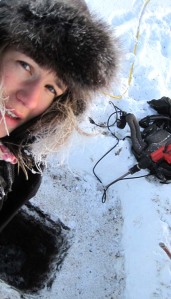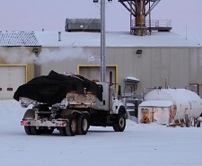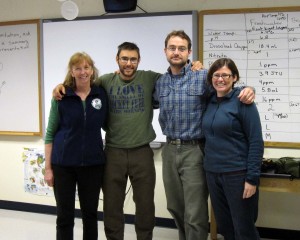In our everyday lives, it’s easy to take for granted our ability to communicate and express exactly “what we mean to say.” If you take a step back, and think about how we are conveying and encoding meaning in our language (be it English, Iñupiaq or any other language), it’s quite a complicated matter! Over the last couple weeks, visiting researcher and linguist Signe Rix Berthelin helped us do just that in her second BASC Saturday Talk, a radio interview on KBRW and a visit with a Barrow High School Iñupiaq class.
Signe Rix Berthelin is a Danish master’s student of linguistics in Norway studying the Iñupiaq language here in Barrow. Besides Danish, English, Norwegian and Iñupiaq, Signe has experience with German and Swahili as well. How’s that for language?! With her breadth of knowledge on various languages, Signe explained and demonstrated to students at BHS all the different approaches one can take to studying a language. Signe’s own work has to do with semantics (meaning of words and expressions) and pragmatics (meaning of words and expressions in context).
One aspect of this that Signe touched on in the classroom with BHS students is the idea of homonymy (when unrelated meanings are expressed by the same word) and polysemy (when words have multiple, but related meanings). With the help of the class, Signe explored examples from English, Danish and Iñupiaq and discussed the distinction between homonymy and polysemy. Homonymy, eg. ‘bear’=the animal and ‘bear’=to carry, is a historical coincidence. Polysemous words are the result of extending the meaning of a word to also cover something else eg. in Danish, where ‘banke’ can mean to knock (on the door) or to beat somebody up. Through these examples, Signe demonstrated how deciding whether the multiple meanings of a word are related is not always a straightforward activity.
The goal of Signe’s research here is Barrow is a detailed description of the Iñupiaq expressions ‘niq’ and ‘guuq’. From the work, she plans to produce a student pamphlet explaining the meanings of these expressions and how to use them while communicating in Iñupiaq and a Master’s Thesis contributing to the documentation and description of the Iñupiaq language. In Barrow, Signe has interviewed speakers of Iñupiaq who have patiently shared their knowledge about the meaning of ‘niq’ and ‘guuq’.
Signe’s Saturday talk, radio interview and visit with students were fun and enlightening opportunities to reconsider the words and language we use everyday!
Signe would like to note that her research is kindly supported by Nordic Association of Linguistics, Barrow Arctic Science Consortium and the Department of Language and Communication Studies at the Norwegian University of Science and Technology.

















